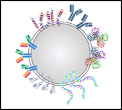Conjugated particles
Micro and nanoparticles can be conjugated with a wide range of biomolecules for being used in biological or chemical assays, among others. One can choose the biomolecule which will cover the particle. Proteins and DNA or RNA molecules are the most usual ones.
Conjugation can be performed in two different ways, by adsorption or by covalent bonding of the biomolecules.

Conjugated particles
Adsorption
Physical adsorption is based on hydrophobic attractions between the hydrophobic portions of ligands and the particle surface. This surface conjugation normally leads to lower amounts of biomolecules covering the particle.
Covalent bonding
Covalent conjugation of nano and microparticles with biomolecules normally makes use of 1-ethyl-3-(3-dimethylaminopropyl)carbodiimide hydrochloride (EDC), which reacts with carboxyl groups to form an intermediate substance capable of reacting with amine groups present on biomolecules. Sulfo-N-hydroxysuccinimide (Sulfo-NHS) can be also added in the conjugation process, creating an amine-reactive Sulfo-NHS ester, which normally improves the efficiency of the coupling reaction. The result is an amide group between the surface particles and the conjugated biomolecule. Normally, the activity and loading amount attained using this procedure is higher than by adsorption.
Other strategies can be also used, depending on the application and necessities.
Biomolecule functionalized Nano and Microparticles
- Streptavidin/Avidin
- Antibodies
- Aptamers
- Oligonucleotides
- Peptides
- Other proteins
Applications
- Sensors
- Biosensors
- Lateral Flow Test
- Medical devices
- Tags or labels
- Cell cytotoxicity
- Purification
- Therapeutics
- Imaging


